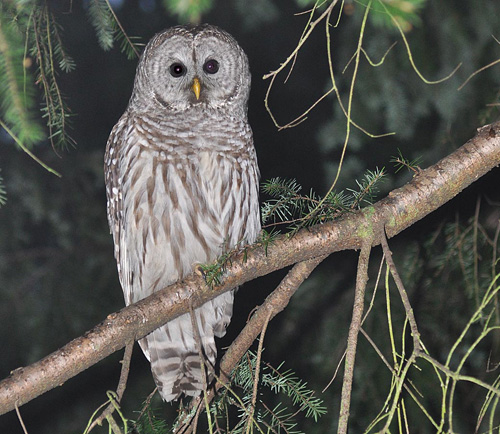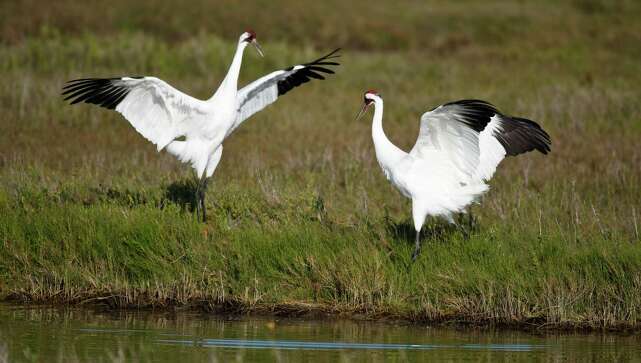For “Winged Wednesday”:
Marañon Crescentchest

“At the Gotas de Agua Reserve in northern Peru, a Marañon Crescentchest delivers a bright series of chirps to announce its presence, then pops into view, showing off sharp black and white wing markings and bold black stripes across its head. Perhaps the most beautiful of all South America’s crescentchests (brightly colored, long-tailed birds of arid habitats in central South America), it is also the most geographically restricted.
Unfortunately, the Marañon Crescentchest’s dry forest habitat is rapidly becoming degraded and fragmented by burning and clearance for cattle pastures, crop cultivation, and oil palm plantations.
The crescentchests at Gotas de Agua can rest a little easier now that 26 acres at this site have received official recognition as a protected area from the Peruvian national government thanks to the efforts of a local private landowner, Luciano Troyes and his family, Asociación Ecosistemas Andinos, American Bird Conservancy, Rainforest Concern, and Martin Stanley.
ABC has worked to promote Gotas de Agua for its conservation importance within a regional conservation plan and as bird-watching destination. Birdwatchers interested in visiting Gotas de Agua should visit Conservation Birding and the reserve’s own website for more information.”
Help ABC conserve this and other birds and their habitats!
Photo: Dubi Shapiro; Range Map, NatureServe
_______
Feathering the Storm

What do birds do in a hurricane? Some of them avoid it; some of them end up 700 miles from home. Photo by Mandel Ngan/AFP/Getty Images.
“As Hurricane Sandy whips the East Coast, people are hunkering down indoors, seeking shelter from the wind and rain. Occasionally they may peek out from their fortresses to see birds cart-wheeling by like scraps of confetti. How do birds stay safe during powerful storms?
By getting out of dodge, going with the flow, or clinging on for dear life. Because birds are so attuned to shifts in barometric pressure, they can often sense ahead of time when a storm is brewing. That advance warning leaves them with several options. Some try to outpace the hurricane, coasting ahead on the propulsion of the storm’s outermost winds.” More at: http://www.slate.com/articles/health_and_science/explainer/2012/10/sandy_2012_what_do_birds_do_in_a_hurricane.html
________
Nature’s Real Vampires: From Leeches to Bats
 Vampires are the stuff of legend, but blood-sucking creatures are a real part of nature.
Vampires are the stuff of legend, but blood-sucking creatures are a real part of nature.
“With Halloween drawing near, our thoughts turn to horror, and among the most popular creatures of horror is the vampire. Although nature has produced no undead beings with the ability to change into bats, it does offer several species that survive by feeding on blood. Here is a sample:
Four Real-Life Vampires:
Vampire finches, Leeches, Vampire Bats, Candiru.” Article at: http://www.nwf.org/News-and-Magazines/National-Wildlife/Animals/Archives/2010/Animal-Vampires.aspx
________
Trivia
"The highest documented flying bird is the Ruppell's Griffon which collided with an airliner in 1973 at 37,000 feet.”
“This Ruppell's Griffon Vulture chick hatched at the Fort Wayne Children's Zoo on February 28, 2011.”
_______
Bald Eagle Hit By A Semi Released Back To The Wild
 “This bald eagle was first introduced to the folks from the Department of Inland Fisheries and Wildlife about five years ago, shortly after it hatched. Before it could even fly, identification bands were attached to its feet.
“This bald eagle was first introduced to the folks from the Department of Inland Fisheries and Wildlife about five years ago, shortly after it hatched. Before it could even fly, identification bands were attached to its feet.
Fast-forward to September 20. "The bird was on the side of the highway, probably flew up into a vehicle going by. I hear it was a semi," Allen said. "It zigged when it should have zagged and ended up entangled in the rear view mirror." More and video at: http://www.wabi.tv/news/33938/bald-eagle-hit-by-a-semi-released-back-to-the-wild
_______
Plan to count whooping cranes ruffles feathers
A male whooping crane tries out some of his moves on a female. Photo: Nick De La Torre / Houston Chronicle
“The whooping crane is North America's tallest bird, standing 5 feet with a wingspan as wide as a pickup. There are not many left, and the last migrating flock in the wild returns each winter to the same marshy flats on the Texas coast. So one might think it should be easy to count every whooper, as they are affectionately known, while they are here, but it's not.” More at: http://www.chron.com/news/houston-texas/article/Whooping-crane-survey-plan-ruffles-feathers-3937397.php
_______
Owls Vocalizing in Fall
“Birdwatchers in Washington State were recently commenting about the increasing vocalizations heard from their local Barred Owls. Why are owls ramping up their territorial calls while most songbirds have already ramped down?”
 Barred Owl © Dennis Paulson
Barred Owl © Dennis Paulson
 Northern Saw-whet Owl © Dennis Paulson
Northern Saw-whet Owl © Dennis Paulson
 Great Horned Owl © Dennis Paulson
Great Horned Owl © Dennis Paulson
Bob Pearson, an owl researcher with 20+ years of experience in the Gifford Pinchot National Forest south of Mount Rainier, provided his observations.
“I find all the owls vocal at this time of year. Since Great Horned Owls nest earlier, and Spotted Owls later, than Barred Owls, I would expect a progression of vocal "reawakening" for these species, but I find them all to start calling more in roughly the same time frame.
I think owls increase their vocalizations as they stop spending time and energy caring for their young. Territories shrink when the birds are taking care of juveniles, concentrating around the nest area. These areas tend to get depleted of prey. Adults can now move around more to find prey and can spend their time finding out what other owls are in the vicinity. The way to do this is to move around and broadcast their presence.
This time of year is also the best acoustically. Sources of outside noise -- such as streams -- are low. There are more likely to be inversions, which keep sounds near the ground and more likely to be heard at a distance. For those of us listening for owls, more owls can be heard simply because the conditions to hear owls are generally much better this time of year.
I also find more interplay between owl species this time of year, by which I mean I'm more likely to have 2 or 3 species calling at the same time. I am more likely to find the owls farther away from their nesting core areas, and sometimes find Barred Owls in adjacent Spotted Owl territories, while the Spotted Owls are in nearby territories for Barred. Great Horned Owls seem to be moving around more and I also find more Saw-whet Owls, with the "skiew" call seeming to be used more often.
Fall may be the best time of year, aided by the good acoustics, for the owls to re-establish boundaries and find out what may be new in a larger area. Testing the specific reasons for increased vocalizations isn't easy, and therefore all theories are educated guesses. Whatever the reason, this is a good time of year to be out listening for owls, and, as a plus, the nights are beautiful, quiet, and may offer the possibility of a shooting star or two.” Bob Pearson, Packwood, WA
Listen to owl vocalizations, with notes, on Bob's website.
On Cornell's All About Birds, listen to vocalizations of:
From: http://birdnote.org/blog/2012/10/owls-vocalizing-fall
_______
Upcoming Shows from BirdNote—a radio program about birds,
the environment, and more.
Eastern Screech-Owl
SUNDAY
The Amazing,
Head-turning Owl
by Bob Sundstrom
LISTEN NOW ►
MONDAY
The Moon of Falling Leaves
by Ellen Blackstone
LISTEN NOW ►
Common Raven
TUESDAY
Ravens and Wolves
by Bob Sundstrom
LISTEN NOW ►
By Louis Agassiz Fuertes
WEDNESDAY
Shakespeare's Crows,
Owls, and Ravens
with Rod Molzahn
LISTEN NOW ►
Northern Pintail
THURSDAY
Tracking Pintail Migration
by Todd Peterson
LISTEN NOW ►
Northern Bobwhite
FRIDAY
On the Trail of the Bobwhite
by Bob Sundstrom
LISTEN NOW ►
Bonaparte's Gulls
SATURDAY
The Spectacle At
Point No Point
by Dennis Paulson
LISTEN NOW ►
________
On This Day:
The U.S. Congress admits Nevada as the 36th state, Oct 31, 1864
“On this day in 1864, anxious to have support of the Republican-dominated Nevada Territory for President Abraham Lincoln's reelection, the U.S. Congress quickly admits Nevada as the 36th state in the Union.
In 1864, Nevada had only 40,000 inhabitants, considerably short of the 60,000 normally required for statehood. But the 1859 discovery of the incredibly large and rich silver deposits at Virginia City had rapidly made the region one of the most important and wealthy in the West. The inexpert miners who initially developed the placer gold deposits at Virginia City had complained for some time about the blue-gray gunk that kept clogging up their gold sluices.
Eventually several of the more experienced miners realized that the gunk the gold miners had been tossing aside was actually rich silver ore, and soon after, they discovered the massive underground silver deposit called the Comstock Lode. Unlike the easily developed placer deposits that had inspired the initial gold rushes to California and Nevada, the Comstock Lode ore demanded a wide array of expensive new technologies for profitable development. For the first time, western mining began to attract investments from large eastern capitalists, and these powerful men began to push for Nevada statehood.
The decisive factor in easing the path to Nevada's statehood was President Lincoln's proposed 13th Amendment banning slavery. Throughout his administration Lincoln had appointed territorial officials in Nevada who were strong Republicans, and he knew he could count on the congressmen and citizens of a new state of Nevada to support him in the coming presidential election and to vote for his proposed amendment. Since time was so short, the Nevada constitutional delegation sent the longest telegram on record up to that time to Washington, D.C., containing the entire text of the proposed state constitution and costing the then astronomical sum of $3,416.77.
Their speedy actions paid off with quick congressional approval of statehood and the new state of Nevada did indeed provide strong support for Lincoln. On January 31, 1865, Congress approved the 13th Amendment to the U.S. Constitution banning slavery.”
________
Yesterday:
Another cool morning, so I turned the heat on in the grooming room.
After I fed the animals, Misty and I went down to Claudia’s to pick up her granddog “Pepper” for grooming.
He is a sweet little guy, but Pepper has Addison’s Disease, and his medication makes him sleepy, so he wants to lie down all the time.
It isn’t very easy to groom a lying down dog, so I had to hold him up a lot of the time. That gets tiring after a while.
At least he isn’t wiggly like “Lil-Miss”, who I had groomed the previous day.


























3 comments:
I have a lot of Barred Owls on my place. I just love to hear them call and chatter. They have some strange vocalizations, for sure.
Hi there. I live in Toronto, Canada, and recently, my wife, Jean, and I came upon an adult Saw-Whet Owl out in the bush. This was the first time as birders that we had ever seen a Saw-Whet Owl. Fortunately, we had our camera with us and got some good pictures and video. We have posted them for anyone interested at: http://frametoframe.ca/photo-essay-northern-saw-whet-owl-sighting
Thank you for your comments DD and Bob.
DD: I used to like to hear the owls at my other place over off Rose Road, too. But when one killed a banded pidgeon that I had saved, taken to a vet in Houston, and tended with a broken wing for months, the owls didn't sound so nice after all.
The pidgeon was all better by then, and had been released back into the wild, but it always stayed close and was part of our family. My son and I were devastated.
Bob: You surely do have some lovely bird pictures, so I have bookmarked the link, as I will look at it again and again. I can tell that you are avid bird lovers.
Happy Tails and Trails, Penny.
Post a Comment